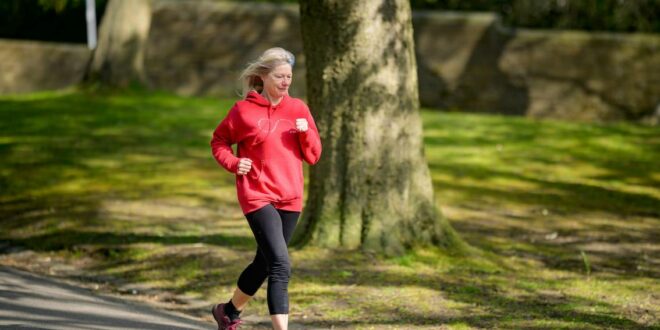Last weekend was a big one for my husband and I; the culmination of months of dedicated training, healthy eating, and positive self-talk. But, as an event official handed me a racing bib to pin to my singlet, the shock of what I saw was almost enough to throw me off balance. There, above my name and race number, and printed in bold black letters, was the word ‘Legend.’
“When did that happen?” I asked my husband.
Every running race has its own categories, and in my event (a half marathon), ‘legend’ was the most senior of them, reserved for women in the 60+ age bracket.
“I guess it had to come some time!” said my husband, as we both burst into laughter, and headed to the start line.
Running isn’t for everyone, and if you’ve not tried it as a form of exercise, it’s important to consult your medical professional before you think about starting. People with advanced osteoporosis, or bone replacements, for example, may have a high risk of injury if they start exercise not suited to their condition. However, if your medical professional gives you the all-clear to run, this sort of exercise can have positive outcomes.
Weight-bearing exercise (exercise performed on your feet and which requires you to bear your body weight) stimulates the cells in our bones to produce more bone tissue, while a loss of bone tissue can contribute to fractures, especially as we grow older. Running also strengthens muscles, contributing to better balance. It improves cardiovascular fitness, and often helps quit stubborn, hard-to-lose body fat.
As with any exercise, the way running is carried out needs to change with ageing. Muscles are slower to recover and repair, once we are older. Whereas, once, you may have enjoyed running almost every day, with increasing years it pays to place more attention on recovery days (a day during which you undertake only light or non-weight-bearing activities). Cross-training is an excellent way to build this discipline into your week. If you’re a runner, think about day-off alternatives involving swimming, cycling, or sports such as golf or kayaking.
Older runners are also at risk from injury to the lower body. Common complaints include ITband (iliotibial band), knee, hamstring, and Achilles tendon injuries. However, if this sounds intimidating, one has only to check out injuries and health issues beset older non-runners, to gain confidence. Even though lower body injuries become more common with runners who are ageing, they can still be mitigated with careful exercises designed to strengthen at-risk areas of the body. Stretching, yoga, and Pilates can help, not to mention well designed running shoes. ‘Warm ups’ will also help you avoid injury. Gentle walking for 3 or 4 minutes prior to running is easy to remember, and slowly signals to muscles activity is beginning.
Runners who are older need to set realistic goals in terms of times and endurance. To expect to achieve similar results to those you experienced even 5 years before, may be a recipe for disappointment and injury. Instead of pitting yourself against others, or even against your younger self, remind yourself you are still fit and active, and even continuing with light jogging is a success!
Running is also about safety. As we grow older, reaction times can decrease. When you are out and about, wear bright clothing, just as you would if riding a bike. If possible, run with friends so you are more visible to traffic. Keep your music turned off so you can hear traffic, and carry your phone.
As my husband and I remind ourselves each day, running can be an enjoyable, healthy activity at any age, provided you have the go-ahead from your health professional. And as for being ‘a legend,’ I wear my race bib with pride!









Join the Discussion
Type out your comment here:
You must be logged in to post a comment.